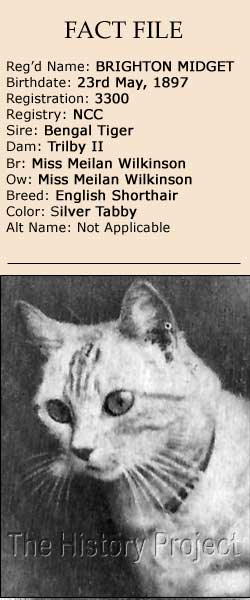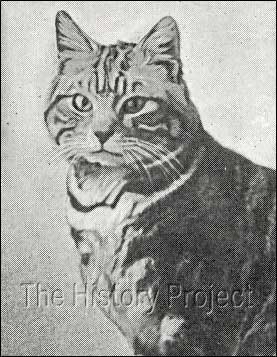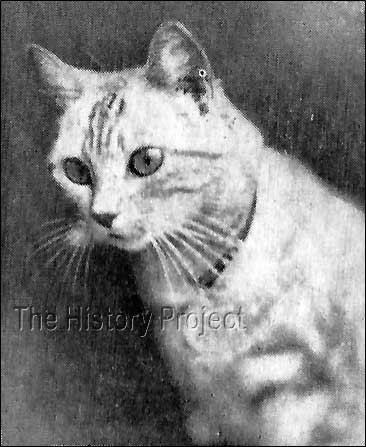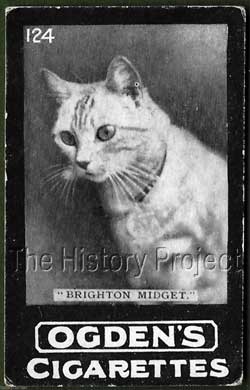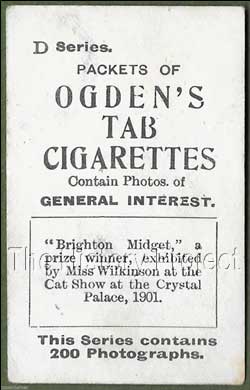 | ||||||||||||||||









|
BRIGHTON MIDGET (1897)PHOTOS | SOCIAL MEDIA | REFERENCES
HISTORICAL BACKGROUND:Although he shared a passion for many varieties of cats, Harrison Weir's greatest love in feline terms was undoubtedly the common English Shorthair, of which the classic tabby, brown or indeed any other colour was his favourite. This passion he encapsulated by entrusting his beautifully pencilled blue Mackerel tabby, 'The Old Lady'3, to be shown at the first Crystal Palace Show in July 1871 'on exhibition only', despite her advancing years. When we get to understand this man's singular loyalty and devotion to original English varieties in all manner of domesticated animals, including the Old English Kent and Sussex fowls for example; then his views about the plain English variety of cat, dovetails perfectly into this historic scenario. But it is also important to put the love of the English Shorthair (later British Shorthair) into context. Not all of the cats registered were pure for short hair. Many carried genes for long hair and produced long-hairs which were registered as long-hairs. This is usual for any domestic population of cats, and these cats were the true English domestics and this was the beginning of recording pedigrees and developing the term 'pedigreed', which simply meant 'of recorded ancestry'. The truth is, however, that when you take any cat off the street, you did not know whether or not a shorthaired cat would carry the genes for long hair, and in those days, little was understood about the genetics of cats. For classification, we must also remember that at this point in time, the main distinction made for English cats, was by coat length! and not solely by breed as it is today. This was not the case for a 'foreign' varieties, where the region of origin prescribed the 'breed' name. So if it came from Siam, it was Siamese, regardless of coat or colour or coat length, and the same applied to Chinese, Turkish, and Abyssinian cats to name but a few. Hence a long-haired cat from North Africa, would be described as a North African Long-haired cat and so forth. So it was not at all unusual to find that Short-hairs and Long-hairs were registered from crosses between registered Long-hairs and registered Short-hairs, and that Long-hairs were on occasion registered out of two registered Short-hairs. When we examine the descendants of our subject cat, this is exactly what we find is the case. As is always the case where competitive classes are developed, fashion and popularity will often dictate what colours and patterns are preferentially developed, retained and exhibited, with the show win in mind. In the period between 1895 and 1905, Silver Tabbies, and Whites predominated, both being similarly successful, but most often the toughest competition was reserved for the Silver Tabby classes, where a cat with a striking pattern, exhibiting clear contrast between the patttern and a clear silver ground colour, would immediately draw the attention of the viewer. This popularity continued when these cats were exported and subsequently bred in the United States, and from these humble beginnings the ever popular Silver Classic Tabby American Shorthair has one of its founding gene pools. PARENTAGE & OWNERSHIP:
Unknown
Bengal Tiger
| Unknown
Brighton Midget, May-23-1897, silver tabby English Shorthair, F
| Muff
Tribly II, silver tabby
Josephine
'Brighton Midget' was born on 23rd May, 1897 and was registered as a Silver Tabby Short-hair in both of the registers of the period, in that of the National Cat Club, in Volume 5, (NCC: 3300) and in the register of The Cat Club, (CCR) in Volume 4. In both registers her breeder and owner are recorded as Miss Meilan Wilkinson, of 57 Brunswick Square, Brighton. And this is where her pedigree gets interesting. Her sire is listed as 'Bengal Tiger'. There are two cats named 'Bengal Tiger', a shorthair belonging to Miss Harper,who appears to be the only likely candidate as her sire and another, who was by Miss Simpson's Brown Tabby Persian, 'Ch. Persimmon'; but this 'Bengal Tiger' was born in 1900, so it was not possible for him to have been the sire of 'Brighton Midget' who was born in 1897. In fact, The Cat Club Register clearly states her sire to be 'Miss Harper's Bengal Tiger', removing all doubt. However, we can only assume that he was a shorthaired cat. The dam of 'Midget', was 'Trilby II' (NCC: 3290) who is a registered silver tabby shorthair. But this is not where the mystery ends, as the line did prove to be carrying long hair, and in fact, long-hairs from Midget were subsequently registered as Long-hairs! (ie. Given the same breed number as imported long-haired cats of the same colour and pattern). 'Trilby II' was registered as a Silver Tabby Shorthair, born in 1894, sired by 'Muff' and out of 'Josephine', but apart from her coat length and show wins, we once again have no clear indication of whether either parent could have been a long-haired cat. SIBLINGS & SHOWS:If ever there was a cat registered and bred from which clearly demonstrates the cross-over between short-hairs and long-hairs, Brighton Midget and her dam 'Trilby II' are prime examples. From the time Midget was born in 1897, we can ascertain that Trilby II carried long-hair. Her daughter Midget, also was proven to carry long hair, as she produced them even when mated to another short-hair, who similarly carried the genes for long hair. When we then analyse a number of other outcrosses for both females, we see with even greater clarity, the effect of this mix and what interesting genetic information it gives us about these and indeed other cats from the period, that they were bred to. There are no recorded sire siblings of 'Brighton Midget' but there area number of dam siblings, most but not all of which were short-haired. In that mix we find, in dated order:
SHOWS Show wins recorded for 'Brighton Midget' include: 2nd at Brighton etc, and 2nd at the Botanic Show, 1899. BREEDING & PROGENY:To understand this confusing mix due to the similarity of names used, we must first look at one of Midget's own progeny, the most interesting of which is from a breeding to 'Jimmy', which resulted in the birth of 'Bengal', a Silver Tabby long-hair, born 10th March, 1899. This 'Bengal' should not to be confused with her own sire 'Bengal Tiger' or her own grandson, 'Bengal Junior' (yet another silver tabby long-hair) by her son 'Bengal', and out of her mother, 'Trilby II'!!! One critical piece of evidence is provided by the registration of her first-born son, 'BENGAL', registered as a SILVER TABBY LONGHAIR, (CCRv5)11, (OC: 26/APR/1900)12 who is clearly noted in the register as a son of Mrs. Herring's exceedingly famous 'Champion Jimmy' who was a Silver Classic Tabby shorthair.
The significance of this result and record is two-fold. It demonstrates beyond reasonable doubt, that registered Longhairs were in some instances produced out of registered shorthairs, in this case, both parents! It also shows that famous shorthairs like 'Champion Jimmy', were already carrying the gene for long hair, and passing it on to at least half of their progeny in subsequent generations. And although we have plenty of empirical evidence of later outcrosses to Persians in the British Shorthair gene pool, this early instance shows that the genes for long hair were already there, latent in the natural and original 'English' short-haired lines, with every possibility of emerging at a later date. In a later breeding, back to her long-haired son 'Bengal', 'Midget' produced a Brown Tabby short-haired male named 'LABHARAIG', born in 1902, bred by Mrs. Wilkinson, and sold to Lady Alexander. (MCCC:1906)15 Yet another 'Sable' or Brown Tabby shorthaired male named 'SABLE TOMMIE' is recorded as born 17th December, 1902, out of 'Brighton Midget' in the NCC listing of registrations published in Our Cats on 26th December, 190316. In this instance, no sire is given but it is possible that this could well have been a litter-mate of 'Labharaig'. PHOTOS:
SOCIAL MEDIA :
Note the claim that 'Brighton Midget' is a prize-winner exhibited at the Crystal Palace, 1901. In fact, she was placed third, in the class for Short-haired silver tabby females. This is confirmed by the Judges Report, published in the 2nd November, 1901 issue of Our Cats Magazine1. In Summary: In studying 'Brighton Midget', we see the serious attempts made by the fanciers and breeders of English shorthairs, to expand their gene pool and to create a greater array of silver tabbies. In the case of Mrs. Meilan Wilkinson, she clearly fancied both long-haired and shorthaired silvers and was not afraid to mix the two together in order to expand those opportunities. It is important not to forget that even the most basic understanding of feline genetics was still very much in its infancy and that the decisions and principles of colour breeding were at this time based almost solely on experience and on the opinions of breeders willing to share the knowledge gained from of their own experimentation. 'Observation' was paramount, as it was in all 'naturalist' fields. The concept that long-hair was a 'recessive' gene that could be carried from one generation of short-hairs to the next, was unknown. Today, we are fortunate that with modern hindsight and clear understanding of fundamental mendelian genetics, we can look back with clarity and deduce the implications of the actions taken by our breeder forebears. Instead of passing judgment on their decisions, we need to use that modern insight to realise how lucky we are today, that without their actions, whether deemed correct or incorrect under modern parameters and scrutiny, we would not have had available to us today, the wonderful fruits of those labours. REFERENCES:
Registers associated with this article include The Incorporated Cat Fanciers Association of Great Britain (TICFAGB), National Cat Club (NCC), The Cat Club (CCR), Beresford Cat Club (BCC), Feline Federation Francaise (FFF), Siamese Cat Registry (SCR), US Register & Studbook for Cats (USR)including Supplement(USRS), The Studbook of the American Cat Association (ACA), and the Studbook & Register of the Cat Fanciers' Association (CFA).
|
|||||||||||||||
Home | Cats | Gallery | Clubs | People | Artifacts | Articles | Updates | Contact Us ©The CFA Foundation, Inc and The Harrison Weir Collection
|
||||||||||||||||
